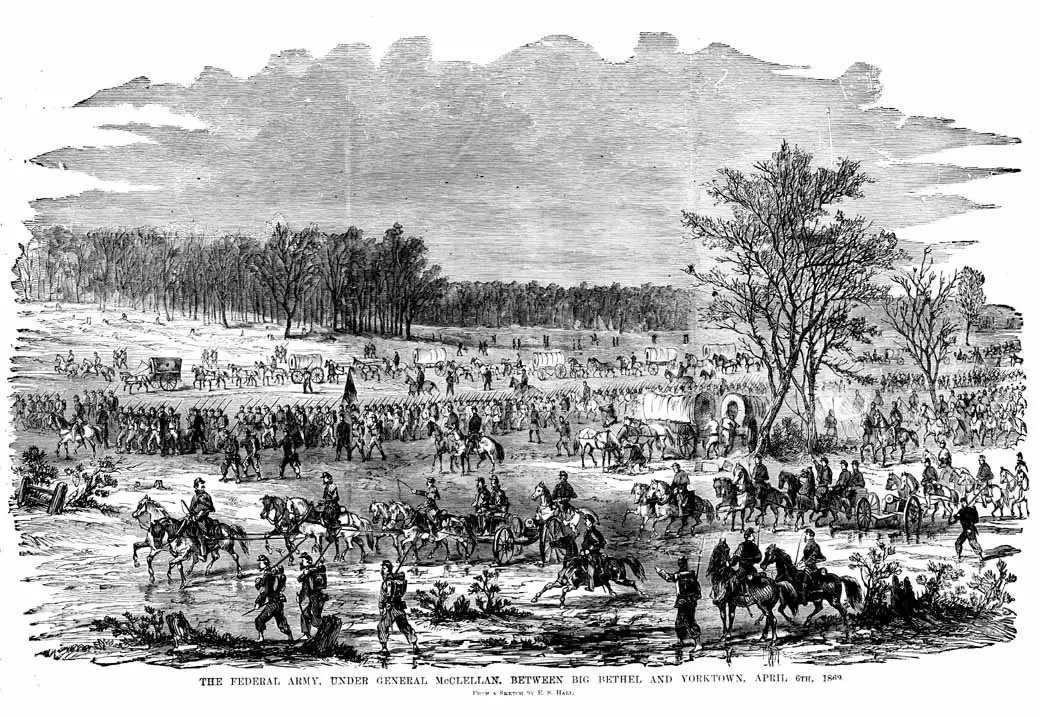Civil War Battles |
Colonial Wars |
American Wars |
Link To This Page — Contact Us —
The Battle of Big Bethel
June 10, 1861 in Big Bethel, Virginia
 Click To Enlarge |
|||||||||||||||||||||
|
The Union control of Fort Monroe on the tip of the Virginia Peninsula between the York and James Rivers enabled them to occupy Hampton and Newport News. This early engagement in southeastern Virginia was one of 3 during June in which the Union army cautiously felt out Confederate positions. Big Bethel caused some embarrasment for the North and brought Maj. George W. Randolph, commanding an artillery battalion, to the attention of his superiors. He would later become the Confederate Sec.-of-War.In order to block Union access up the peninsula from this stronghold, the Confederates dug a mile-long line of entrenchments north of Marsh Creek (now Brick Kiln Creek) near the village of Big Bethel. These were held by 1,200 troops commanded by Cols. John B. Magruder and Daniel Harvey Hill. A redoubt south of their line protected a bridge over the stream leading into the Confederate center.
The plan of attack, drawn up by Maj. Winthrop of the 7th New York News and the other from Camp Hamilton, take both the Confederates and the Volunteer Regiment, was to march 2 columns north, one from Newport churches, first Little Bethel and then Big Bethel, and burn the churches. The attack was scheduled to take place just before dawn or at dawn of the 10th, so the columns took off the night of the 9th. Winthrop knew the problems of night attacks. To avoid confusion in the dark, the men were to wear white rags around their left arms and yell “Boston” if they encountered one another. But the precautions failed. In the dark, 2 regiments mistook each other for the enemy and opened fire, killing several of their own. Once the mistake was realized, the Federals, after a brief retreat, reorganized, and again marched on the Confederates. The
Confederates, under the command of Col. John B. Magruder, abandoned Little Bethel and took up positions around Big Bethel on the north side of Back Creek (Marsh Creek) on the road from Hampton and Yorktown. To the right of the road stood a battery of 2 guns under the command of Maj. George W. Randolph. On their right flank, across the creek, was a single cannon, which had to stop firing when a priming wire broke (the cannon was eventually replaced). Another cannon, situated in the left of the road, protected the bridge across the creek. The infantry were protected by breastworks.
 |
As the Federals approached their objective, they came under fire from the Confederate artillery, primarily Randolph’s battery, who, during the course of the engagement, fired a total of 98 rounds. The attacking Federals took cover behind 2 farmhouses and in a tree line and returned fire, but the Union artillery proved ineffective. Maj. Randolph reported the enemy “fired upon us with shot, shell, spherical case, canister, and grape from 6 and 12-pounders, at a distance of about six hundred yards, but the only injury received from their artillery was the loss of 1 mule.” The Federals attempted several direct assaults on the Confederate positions A Richmond newspaper printed an account by a Confederate soldier in the battle who captured the actions of one Union officer during an assault: “Their captain, a fine-looking man, reached the fence, and, leaping on a log, waved his sword, crying ‘Come on, boys; one charge and the day is ours.’ The words were his last, for a Carolina rifle ended his life the next moment, and his men fled in terror back.” The Captain was in fact Maj. Winthrop, the moving spirit of the whole enterprise. The fire from Randolph’s battery was just too much for the attacking troops, as Capt. Judson Kilpatrick of the 5th New York Regiment wrote: “The Confederate's ’s fire . . . began to tell upon us with great effect: my men were falling one after another, as was the case of the rest of the command.”
By 12:30 P.M., Union forces began their retreat from battlefield, pursued by 4 cavalry companies who pursued the defeated Federals all the way to Black River, where the cavalry were stopped since the Federals had destroyed the bridge. Thus, the first serious engagement of the Civil War concluded.. The only Confederate fatality was Pvt. Henry L. Wyatt, who had jumped over a parapet and tried to burn one of the farmhouses being held by the Federals. Three other Confederates were wounded. On the other side, the Union forces suffered 76 casualties--18 killed (including Maj.Winthrop), 53 wounded, and 5 missing.
Later that same day, the Confederates abandoned their positions for the more secure defenses of Yorktown. The military effects of the battle were minor, but it was heavily reported in newspapers, contributing to the martial mood. Confederates displayed trophies of the fight in Richmond store windows.
